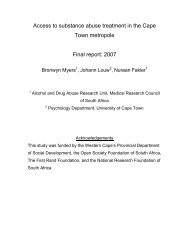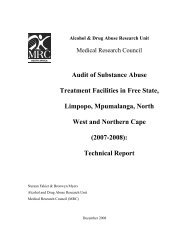Pan-African Conference 21 - 24 July 2002 Inter-Continental Hotel ...
Pan-African Conference 21 - 24 July 2002 Inter-Continental Hotel ...
Pan-African Conference 21 - 24 July 2002 Inter-Continental Hotel ...
Create successful ePaper yourself
Turn your PDF publications into a flip-book with our unique Google optimized e-Paper software.
Abstracts 10/22/02 11:26 AM Page 35<br />
ABSTRACT NO. 58. MINERALS CHARACTERIZATION OF TABLE SALT<br />
IN MOROCCO<br />
Bahbouhi I, Belahsen R<br />
Training and Research Unit on Food Sciences. Laboratory of Physiology Applied to<br />
Nutrition and Alimentation. Chouaïb Doukkali University. School of Sciences P.O.<br />
Box 20. El Jadida, <strong>24</strong>000, Morocco<br />
The table salt used in Morocco is from different sources: rock salt, sea salt and<br />
refined salt iodized or not iodized. The rock salt is consumed by the<br />
population in the mountain areas. Mineral composition of rock salt is different<br />
according to the location and the environment of the mines. The fact that the<br />
content of some trace elements or micro nutrients could be higher or lower<br />
than those recommended will have consequences on health. In this study the<br />
goal was to characterize different samples of salt by evaluating and comparing<br />
their chemical composition especially their content in some elements (Cl, Na,<br />
Mg, K, SO 4, I 2, Cu, Pb) and physical properties. This characterization is<br />
important for salt fortification with micronutrient such as iodine. The results<br />
are discussed on the basis of the improvement of the salt composition for<br />
dietary use.<br />
ABSTRACT NO. 59. LIPID PROFILE AND PREVALENCE OF<br />
CARDIOVASCULAR RISK FACTORS IN A POPULATION OF WOMEN<br />
OF MOROCCO<br />
E l Ayachi M 1,2 , Mziwira M1, Belahsen R 1 , Lairon D 2<br />
1 Laboratoire de Physiologie appliquée à la nutrition et à l'AlimentationUnité de<br />
Formation et de Recherche "Sciences de l'Alimentation"Université Chouaïb<br />
DoukkaliFaculté des Sciences<br />
El Jadida, Maroc<br />
2Laboratoire de Nutrition Humaine et Lipides, U476, INSERM, Centre Viton,<br />
Marseille, France<br />
The aim of this study was to evaluate the lipid, lipoprotein and apolipoprotein<br />
profile, the prevalence of cardiovascular risk factors and to examine its<br />
relationship with age in urban population of adult women from El Jadida city<br />
in Morocco. A sample of <strong>21</strong>9 women, 25-55 years old were included in this<br />
study. Lipid profile parameters were determined including triglyceride-rich<br />
lipoprotein triglycerides (TRL), triglyceride-rich lipoprotein cholesterol, total<br />
triglyceride (TG), total cholesterol (CT), low-density lipoprotein (LDL)<br />
cholesterol and high-density lipoprotein (HDL) cholesterol, apo lipoprotein<br />
AI, B, B48, CIII, and E, and glycaemia. The results showed that the risk of<br />
cardiovascular disease was characterized by limiting and increased total and<br />
LDL-C cholesterol levels in 10% and 19.4% respectively; decreased HDL-C<br />
levels in 43.3%; increased triglyceride levels in 11.9%, and increased glucose<br />
levels in <strong>24</strong>.6%. TRL-CT level higher than 0.6 mmol/l was presented in 13.4%.<br />
TRL-TG level higher than 0.8 mmol/l was presented in 16.6%. Triglycerides<br />
and glucose concentrations were increased with age APO CIII and TRL-TG are<br />
all closely correlated with total triglycerides (R=0.52, P=0.0001 and R=0.86,<br />
P=0.0001, respectively).<br />
The study showed that there is a high prevalence of some risk factors of<br />
cardiovascular diseases associated with an altered lipid profile which is age<br />
dependant in the Moroccan population of women studied.<br />
ABSTRACT NO. 73. Family involvement in growth monitoring and<br />
nutrition<br />
Hamedy P, Kolahdooz F<br />
NNFTRI, Iran<br />
It is now accepted that family involvement is central to any effective health<br />
education activity. Growth monitoring and Nutrition education have been less<br />
successful than they should have been because the family has not been<br />
involved family members need to be able to assimilate and act upon the in<br />
formation received. Unfortunately many growth-monitoring programmers<br />
have neglected or at least only nominally involved these key personnel<br />
particularly the influential family members many Nutrition education<br />
programs have concentrated on transferring the message not considering<br />
appropriateness or feasibility. The audience is often perceived as ? having a<br />
ABSTRACTS<br />
problem ? namely ignorance. They are the victims. Using key technical areas<br />
for involvement such as providing a sufficient energy concentrated diet for<br />
young children this paper suggests mechanism for enabling family members<br />
to become participatorier. Methods for more active involvement of parents<br />
and the community in the growth process direct weighing, their ability to<br />
interpret the growth curve and decide what action to initiate are discussed.<br />
F.G.D. (Focus group discussion) is the best way to facilitate family members<br />
and the wider community in having more Autonomy in their lives.<br />
ABSTRACT NO. 86. A PROJECT FOR CREATING AN INFANT<br />
NUTRITION DATA BASE IN CHAD<br />
Francis Beninga Deouro<br />
Faculté des Sciences BP 1027 N’Djaména, CHAD<br />
Chad has several geographical zones reflected in the diet like this:<br />
- in the South, the diet is dominated by roots and tubers (cassava, sweet potato,<br />
yam) and by white sorghum;<br />
- in the Central South, the diet is based on sorghum (red and white) and on<br />
rice;<br />
- in the Central part, the diet is based on sorghum (red and white) and millet;<br />
- in the North the diet is based on millet and dates.<br />
As a complement to the different sorghums and roots and tubers, which serve<br />
to prepare the staple paste, a sauce with vegetables, meat or fish is served.<br />
Cattle or camel rearing also dominates the country. The diets of the infants<br />
conform to this dietary diversity. The young children have for the first three<br />
months a diet based on breast milk. From 3 months of age the breast milk is<br />
complemented by thin gruels. The gruels are based on sorghum, roots and<br />
tubers, dates, peanut butter and water.<br />
From six months the gruel is made thicker and the infants are also given meat<br />
sauces, vegetables and fish. At 18 months the breastfeeding is discontinued<br />
and the child is served the same food as the rest of the family.<br />
PROJET DE CRÉATION DE BASES DE DONNÉES<br />
DE NUTRITION ALIMENTAIRE INFANTILE AU TCHAD<br />
Francis Beninga Deouro<br />
Faculté des Sciences BP 1027 N’Djaména<br />
Le Tchad est un pays ayant une spécificité géographique liée à l’alimentation,<br />
qui est repartie comme suit:<br />
- à l’extrême sud, elle est dominée par les tubercules (manioc, patate, igname)<br />
et du sorgho mil blanc ;<br />
- au centre sud, l’alimentation repose essentiellement sur le sorgho mil (rouge<br />
et blanc) et du riz ;<br />
- au centre du pays, l’alimentation est basée sur le sorgho (mil blanc et rouge,<br />
le béré-béré, le petit mil ou pénicillaire) ;<br />
- au nord et extrême nord l’alimentation est basée sur le mil et les dattes.<br />
Comme complément de ces différents sorghos et tubercules qui servent à<br />
préparer la bouillie ou boule à base des farines, on complète avec la sauce de<br />
légumes, viandes ou poisson.<br />
L’élevage prédomine également dans le pays, la densité d’élevage du bovin et<br />
ovins diminue du centre vers le sud ou le nord. Au nord c’est l’élevage des<br />
chameaux qui est fait.<br />
Conformément à sa diversité alimentaire, la nutrition infantile suit exactement<br />
cette diversité. Les jeunes enfants tchadiens ont exclusivement à la naissance<br />
une alimentation basée sur le lait maternel jusqu’à l’âge de trois mois. A partir<br />
de trois mois, on complète le lait maternel par la bouillie légère. La préparation<br />
de la bouillie est constituée de la farine (sorgho, tubercule, datte), de la pâte<br />
d’arachide et d’eau qui représente 80 % de la constitution.<br />
A partir de 6 mois le volume d’eau diminue à 60% pour faire place à<br />
l’augmentation du volume de la farine et de la pâte. A cette âge on commence<br />
à donner le jus de la viande, de légume ou du poisson. La boule (couscous de<br />
farine de sorgho ou tubercule) est la nourriture de base. A 18 mois on arrête<br />
l’allaitement de l’enfant, et l’enfant est servi intégralement la nourriture de la<br />
famille.<br />
S35

















